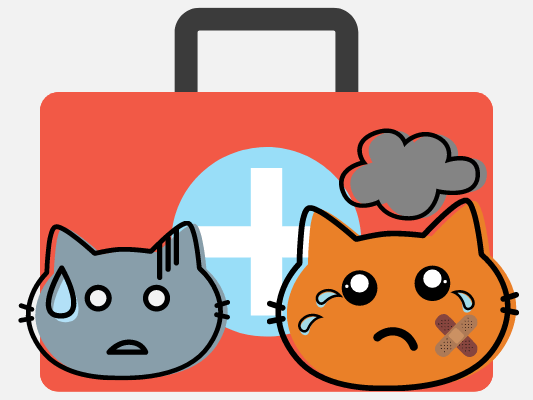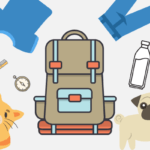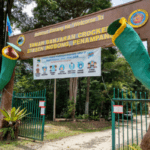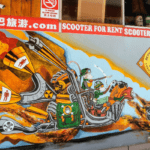Wilderness First Aid Kit for Hiking and Jungle Trekking
This post explains what I pack into my first aid kit for hiking and jungle trekking, adapted from the book ‘Wilderness Medicine: Beyond First Aid (2012)‘, by Dr William Forgey. The information below serves only as a reference for the readers, as I am not an expert in the field of first aid and medicine.
Why bother bringing a First Aid Kit?
First of all, first aid is the first set of actions taken toward self or others who are injured, in order to preserve life, to prevent worsening conditions, or to promote recovery. A first aid kit is a set of supplies to give medical attention for the phases above. Other than that, having a first aid kit by your side provides a sense of security, especially in the wilderness, where immediate care by medical professionals is not possible. In some events, bringing a first aid kit could be a life-changing decision, such as saving life and preventing permanent disability.
Just having a First Aid Kit is Not Enough
A first aid kit would not be useful if you do not know how to use it, or if the kit is not properly equipped. Make sure you are well prepared and practice on how to perform and use your first aid kit beforehand.
What I do is to get an electronic copy (e-book) of the book I have mentioned above (or you may get the latest edition here), and save it into my phone. It has a useful ‘how to use this book’ guide, which by a quick glance, you can turn to the specific pages you need during an event, such as physical examination checklist and specific treatment options (eg. bee stings, soft tissue care, etc.). I bring my DIY first aid kit constructed based on the book’s guidelines, as the treatment options guides in the book will tell me which items and medications to use. It is recommended to read and revise the guides at least for a few times, it is so much easier to absorb information when not in an urgent or emergency situation.
Standard VS Wilderness First Aid Kit
While it should be alright to buy pre-packed standard first aid kits from stores, they are usually less efficient, heavier and bulkier. It would not be convenient to carry one around for a long day of hiking or jungle trekking. Furthermore, the standard first aid kits usually focus on providing first aid treatment in urban environments, where the injured person could be quickly sent to a proper facility for further treatments.
A wilderness first aid kit, however, is constructed based on the expectation that one will not get help for many hours, or even days, when an accident happens deep in the wilderness. The wilderness first aid kit is expected to be used in times when professional aid is not accessible, and an injured person is expected to rely on oneself, the team and the kit, for an extended period of time, to evacuate back to civilization, before receiving proper treatment.
It is more helpful to have basic first aid knowledge before moving into more advanced techniques. I love Dr Forgey’s book as it covers the basics, and guides the readers through the more advanced (yet easy to follow) techniques needed for various complex situations. The book, however, should not be seen as a substitution for other first aid manuals or certified courses, but as an enhancement tool for new knowledge and skill improvements.
Basic First Aid Kit For Hiking Trips
Before I move on to the more advanced preparation for the deep wilderness exploration pack, here are the basic first aid kits you should have for a short hiking trip or daypack (item details are explained in the advanced sections):
- Wound Dressings/Gauze Dressings (2-4 pieces)
- Blister Plasters (2-4 strips)
- Gauze Pads (2-3 packets)
- Bandage Strips / Plasters (2-6 strips)
- Surgical Tape (1 small roll)
- Elastic Bandages (1 roll of each size: 2″ & 3″)
- Antibiotic Ointment (one mini tube)
- Protective Gloves (1 pair)
- Mini Tongs (1)
- Ibuprofen Tablets
The list looks like a lot but the items are very lightweight and small altogether, which can be packed as a rather flat packagings in a small waterproof or ziplock bag. I usually bring these items even on easy and popular hiking places such as Bukit Gasing and Bukit Ketumbar, and I used these items for treating other hikers more than using them on myself.
Preparing First Aid Kit for Wilderness Adventures
When it comes to long distance hiking or jungle trekking, weight and size is a big deal. Again, the items listed below are adapted from Dr Forgey’s book, ”Wilderness Medicine: Beyond First Aid (2012)‘. The items are multi-purpose and multifunction, so that one could have a first aid kit that is compact, yet provides a wide treatment coverage for different situations. While the book covers both non-RX and RX medications (RX means that a prescription is needed to obtain the medication), I will only cover some of the Topical Bandaging Items and non-RX medications, as they will generally fulfill a vast majority of the emergency treatment requirements. I highly recommend buying the electronic version of the book (latest edition).
Below items are stated with the minimum quantity needed for a two-person team, heading into a remote area lasting for around 3 weeks. Some items have alternative improvisation stated below, which you could decide to remove some items from the list.
Topical Bandaging Items
Wound Dressings/Gauze Dressings (10 pieces):
- To cover and protect the wound from outside.
- Speed up healing by accelerating blood clotting, and hold laceration close.
- Alternative: Use cellophane or duct tape to cover the wound. Remember to cover the adhesive part in the middle with another tape, where it will be placed above the wound, so it does not stick to the wound.
Blister Plasters (1 packet):
- Great for prevention and treatment for friction blisters.
- Can be used to cover burns.
- Alternative: Piece of tape
Gauze Pads (15 packets):
- For bleeding wounds.
- Alternative: Cotton clothes; bandanas.
Bandage Strips (25 pieces):
- Common 1″ x 3″ plasters. For minor cuts and scratches.
- Alternative: Tapes, similar to wound dressings above.
Duct Tape:
- A more useful, multipurpose replacement for surgical tape.
- Can be used as a waterproof tape for bandaging or splinting applications.
- Get a compact roll of duct tape, or re-roll it onto a thinner rod to save space.
Elastic Bandages (One roll of each size: 2″, 3″, 6″):
- For sprained ankles, muscle/joint injuries, large lacerations, to apply pressure on neurotoxin snake bites, etc.
- Alternative: Stretchy clothes; firmly wrapped clothes.
Antibiotic Ointment (one tube, 20-30g)
- As prevention and treatment for minor infections for abrasions and burns.
- While the recommended product is a maximum strength antibiotic ointment containing 500 units of Bacitracin, 3.5mg Neomycin Sulphate, 10,000 units Polymyxin B Sulphate, with 10mg of anaesthetic Pramoxine Hydrochloride, I use a regular tube with 250 units of Bacitracin and 5000 units of Neomycin Sulphate.
- Neomycin can cause skin rashes on some individuals. If it occurs, counter the effect with Hydrocortisone Cream.
Hydrocortisone Cream (one tube, 20-30g)
- For allergic skin rashes.
- Ideal for treating weeping lesions as a cream.
- Alternative: Applying a cloth made wet with concentrated salt solution on blistery rashes to soothe the skin and to dry to leaking fluid.
Antifungal Cream (one tube, 15g)
- For possible fungal infections (for foot, groin, etc.). Apply twice daily.
- Alternative: Cooking oil to soothe.
Protective Gloves (2 pairs)
- To protect against blood-borne pathogens, such as AIDS, hepatitis B and C, when handling patients.
- Alternative: Waterproof bags; waterproof materials wrapped around the hand.
Surgical Scrub & Irrigation Syringe
- For forceful irrigation to clean the wound and dilute the germ count.
- “The solution to pollution is dilution.”
- Alternative: Pouring clean water from a height to the wound with a brisk scrubbing action using a soft, clean cloth; Portable Bidet.
Mini Tongs
- Always helpful when a tiny thorn pieces into your skin. Better to pick it out right away than to wait until you’re out of the jungle. Having a prickly sensation throughout the journey, and knowing that there’s a foreign object under your skin, is very irritating.
Surgical Kit with Needle Holder and Ethicon Sutures
- Needle & Threads to fasten serious gaping wounds.
- Alternative: Wound dressing; Internal pressure packing (wet a cloth with clean water, wring it dry and firmly stuff into the wound, continue to pack more clothes into the wound until bleeding is stopped).
- This might be too advanced for casual hikers like me. Please consult with experts or learn through proper sources rather than from my post.
Non-RX Oral Medications
Ibuprofen Tablets 200mg
- Relieves pain, fever, inflammation and menstrual cramps.
- Non-RX dosage: 2 tables 4 times a day (if you have 400mg tablets, then cut down to 1 tablet each time).
- Shall not be taken with an empty stomach to prevent heartburn.
Loperamide Tablets 2mg
- Anti-diarrheal
- 2 tablets after first loose bowel movement, and 1 tablet after each subsequent ones, but no more than 4 tablets a day, and no more than 2 days.
Bisacodyl Tablets 5mg
- For constipation.
- Use 1 tablet to form a soft stool within 6 to 10 hours.
Special: Pil Chi Kit Teck Aun
- Malaysians’ pride, most of us will make sure to pack a few packs when traveling.
- It’s a traditional Chinese medicine to relieve mild diarrhea, stomach ache, vomiting, and motion sickness.
- Alternative: Po Chai Pills (made in Hong Kong)
- CAUTION: DO NOT MIX/TAKE WESTERN AND CHINESE MEDICINE WITHIN THE SAME PERIOD OF TIME
Customizing First Aid Kit for different Durations and Activities
As you can see from the list above, the items to bring are quite extensive to cover most of the possible treatments needed in the wild. If you are just going for a day pack, then you wouldn’t need to bring the oral medications, creams, and some other items listed above. It’s good to have gauze pads, dressings, plasters and tape with you on all trips.
For much extended expeditions (eg. more than a month), other than a higher quantity, you would need to include more items such as:
- Dental Filling Paste: temporary tooth cavity treatment
- Various RX Medications: for more extensive and advanced patient care, which you need a prescription from a physician. Read Dr Forgey’s book for the details.
Also, please make sure that the pouch for your first aid kit is resealable and waterproof.
Epilogue
To conclude, it’s definitely better to be well prepared, than finding oneself in deep trouble when things go South and there’s nothing to aid the situation. Having a well prepared first aid kit in the wilderness is just as important as the healing items in your video game… actually… much more important because in real life, there’s no extra life or auto-respawn features.
Again, for preparing a first aid kit for hiking or jungle trekking activities, and to have on-demand reference for the first aid scenarios, I highly recommend this book.
*Captain Planet passing by* Remember, please take care of our environment, and please don’t destroy the Nature. Leave no trash behind and take back only photos and memories (and also some trash if you can). Walk on the designated path and stay in the middle as much as you can, so that the exposed soil doesn’t spread/corrode further. BE ONE WITH NATURE *flies away*
Yay for transparency!: Some of the links here are affiliate links, and at no additional cost to you, I earn a commission if you make a booking. I recommend only products and companies I use. Your support helps me keep the site going 🙂




